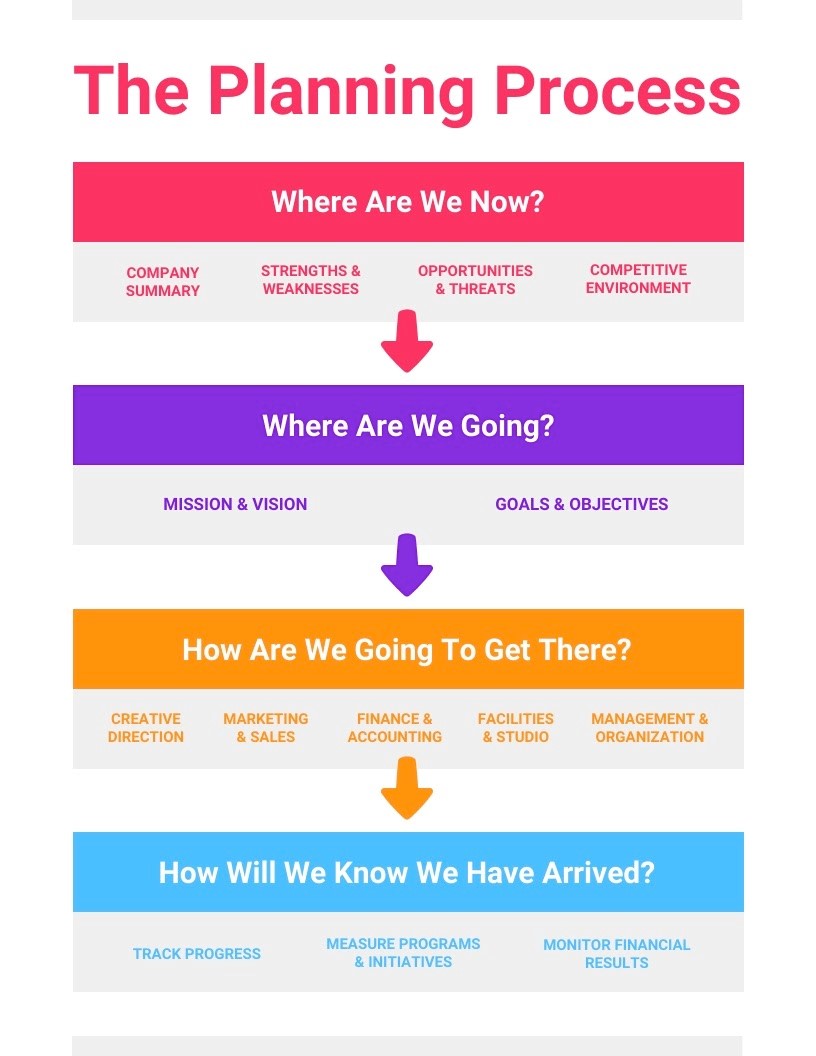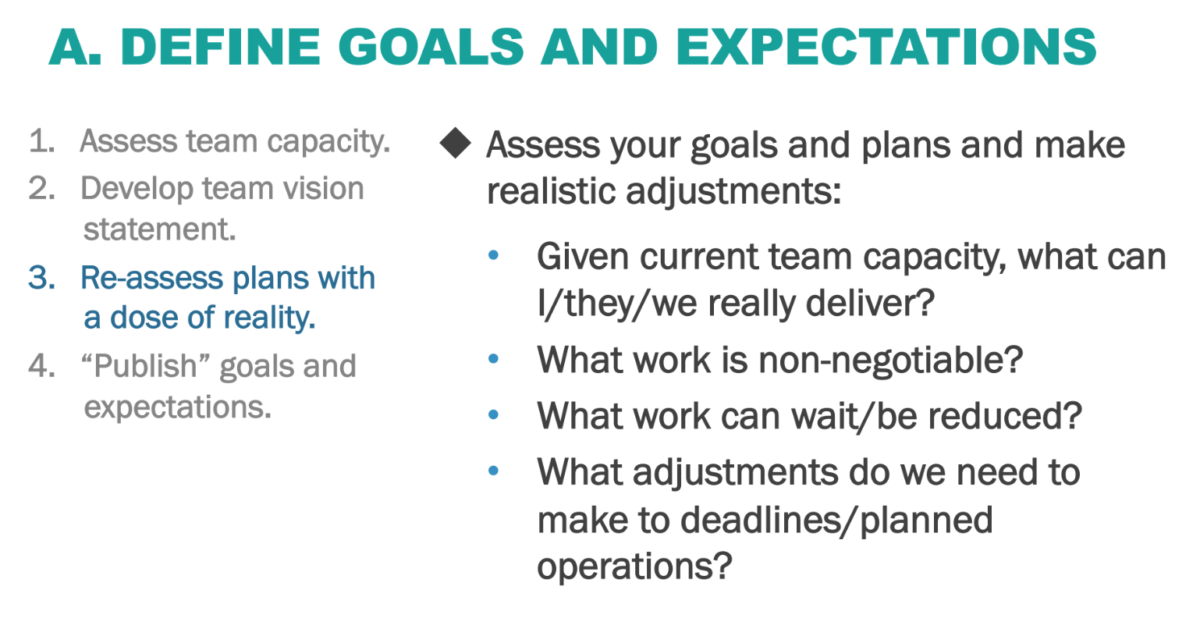What Are Some Effective Work From Home Guidelines?
This refers to the guidelines that you instill for every remote team member to follow. Its limitations define any successful work-from-home program. Distributed teams seldom have the luxury of meeting with each other face-to-face, making team alignment, collaboration, and overall success much more challenging in remote settings. Working from home requires some degree of structure to keep everyone in the company forward-thinking and -moving.
The remote guidelines you establish should be based on the unique specifications that a business of your workforce size and industry demands. A company that offers customer support around the clock, for example, may have a different range of working hours for remote employees than those who only serve customers during traditional business hours.
To start developing your work from home guidelines, consider your answers to the following questions:
- Are there specific hours where everyone in my business should be expected to work?
- Should my employees avoid working on public or unsecured internet connections?
- How often should team members check in with their managers or project leads?
- Do I have a way to gauge worker productivity and proficiency outside of our office?
- Is there a maximum number of hours that I want employees to work off-site vs. on-site?
- Should the entire company be eligible for remote work, or is it an earned benefit?
How To Make Remote Teams More Productive:
Remote teams can find being productive a challenge. It’s no doubt the current global environment has impacted the way we work and do business.
Being outside the workplace impacts how one executes their tasks. It determines what works best when you can’t meet people face-to-face or walk over to your coworkers can be difficult.
We have seven methods that remote teams can adopt to increase productivity until returning to their office spaces.
1. Get Feedback on Remote Working
Remote working isn’t something everyone is familiar with, but it has its advantages, and by now, people are becoming used to this new method of working.
As we settle into what will likely be more months of working from home, team managers should encourage employees to share their new working model experiences.
Weekly check-ins on the following should become part of the management plan:
- What roadblocks are staff facing due to the change in working conditions?
- What are they enjoying about working from home?
- Any suggestions for replicating the work environment at home, or vice versa?
- What remains to be done in terms of making this system more efficient?
- Any misunderstandings arising from the new situation?
Asking these questions will help remote teams become more efficient. The answers to these questions will lead to more productivity and better results.
Managers can map these processes out on a timeline to share and create a more productive environment with the company.
2. Communicate Often
Working apart from colleagues makes communication taxing. People no longer have the option of stopping by someone’s desk for a quick update or a chat.
Not only does this exacerbate feelings of isolation, but it can also lead to employees feeling disconnected from their management teams and decreased productivity.
It is necessary, in such circumstances, to hold regular meetings with individual employees or teams.
These can be quick, 15-minute sessions where the parties involved share their thoughts. Or an hour-long meeting where everyone gives their updates, learnings, strategies, and ideas.
Regular communication is especially vital for businesses that have transitioned into eCommerce models. A different way of working requires teams to update each other regularly.
Regularly keeping a designated time available could also work. Scheduling an hour or two every day or every few days when people can virtually drop in allows everyone flexibility.
Whatever the communication method, it should always be an option to facilitate better connections between staff and mitigate loneliness.
3. Connect For More Than Work

For most, feelings of isolation can be overwhelming, especially when you’ve suddenly been moved away from your workplace.
Employees who are working from home may have families to stay with. This gives them the much-needed human interaction that powers people through the day.
But a few people don’t have anyone at home—being on one’s own can be demotivating and counter-productive.
To help remote teams work successfully, managers should create spaces where employees can enjoy conversations unrelated to work.
Team meetings should allow for moments where people can share how they’re dealing with isolation and fun activities that they may be doing at home.
And managers shouldn’t hold back on any praise for the company’s or individual employees’ achievements. Any good news is like a lifeline during this period.
Hold online events and invite everyone to join. You can use newsletter templates to design fun invitations for the staff.
4. Be Clear About Expectations
Setting employees’ expectations should always be a priority, whether teams work from home or within the office.
When one doesn’t know what to do or data points to achieve, the chances of their productivity dipping understandably increase.
It becomes even more necessary in the remote working environment to be clear about staff expectations.
It would be best if some time is taken to onboard remote teams into the new working process. Some of the areas that need to be addressed include:
- What are the tasks that individuals should focus on?
- Are there any deadlines per task?
- Which goals should they aim to achieve?
- Are their reference materials to glean quality standards?
- What equipment can and should be used to accomplish these tasks?
With clearly defined expectations, employees will be better able to achieve their individual and team goals. Most employees can achieve these goals no matter their working environment.
5. Prioritize Results, Not Hours
Far too many managers reward the length of time spent working than how efficiently results are achieved. And this approach becomes exacerbated when everyone is working from home.
Remote managers can’t check on what their teams are doing during designated work hours. Unlike in the office space when you know when someone is or isn’t at their desk.
And it isn’t reasonable to expect people to work at home precisely the same way they would in the office. Many people have children at home and are working around their schedules.
Instead of insisting that staff work long hours, it is better to focus on how and when they achieve their desired results. This type of focus will lead to a more productive mindset.
Give teams actionable targets and deliverables to aim for—and be flexible if they face any roadblocks and pressures.
6. Support Your Colleagues
The transition to remote work—and the certainty that this may be the future for several workplaces—has been a hurdle for workplaces.
Managers, staff, and C-Suite executives all need to come together in support of each other during this difficult time.
Understanding each other’s limitations—regarding connectivity, available hours, or extraneous needs—should be acknowledged and accounted for.
Checking in on each other regularly—even just a quick ‘hi’—helps people stay connected, feel less abandoned, and boost productivity.
Adding more onboarding and training can seem like a chore, but if it helps people work better, this is an exercise worth undergoing on a company-wide basis.
Most importantly, no matter what level they work at, all employees should feel like they have someone to turn to. Also, someone who has their back if things do go wrong.
What Technology Should I Use When Working From Home?

Whether a team has only one employee or 50, it is evident that communication has to be a priority.
For remote management to be a success, it isn’t enough to rely on email. It’s a communication channel that works better for external parties but doesn’t capture the expediency now required.
There’s a good chance that remote work will require a different set of tools, technology, and resources for your team to function similarly to how you work on-site. Technology is imperative to the work from home experience that 85% of workers state that they would like their employers to provide them with appropriate technology for remote work. With the right combination of tools, many smaller teams can bridge the distance gap for an in-office experience.
Use Communication Tools
The first and most crucial step is to revamp your communication efforts. Yes, phone calls and text messaging are undoubtedly sufficient for quick touch-bases. But long-term remote work requires channels that are better at emulating body language and other visual cues. Integrating a video conferencing tool into your remote communication package is the best solution for several businesses. Also, many video meeting services offer both free and paid platforms. These tools can help you stay connected without generating additional overhead.
Several remote tools make communication far more efficient than email. To facilitate fast and efficient communication, using online tools leads to more productivity.
Apps such as Slack and Microsoft Teams are primarily messaging tools, mainly text-based—with audio and video components—and facilitate instantaneous conversation.
Video conferencing tools like Zoom, Skype, and Google Meet allow people to engage in face-to-face communication. These innovations are sorely needed during remote work.
And anyone using video calls should be encouraged to switch their video on as often as possible. Seeing colleagues helps to forge bonds when working apart.
Another set of tools that many companies are now using include project management tools like Trello and Asana.
These tools make collaboration more efficient, and one can invite people using the same domain or different domains.
Most of these systems are relatively intuitive to understand and use. You can tag colleagues, add deadlines, and create checklists to make the process more effective.
Using tools to promote productivity is necessary for remote teams, but managers can easily continue it once companies are back in their office spaces.
Remote Work May Change Your Approach To Customer Management
Customer information stored on local networks can be complicated to keep updated when working outside of your headquarters. This could include data stored on customer relationship management tools (CRM) or even just personal spreadsheets. Larger teams are more prone to this issue. They tend to have multiple users accessing and editing the same resources at once.
Utilizing cloud-based customer relationship management helps small businesses navigate these problems and connect their sales, marketing, and support teams with potential and current buyers.
One final, notable challenge that technology helps solve is worker alignment. How can you guarantee that your teams are working in tandem and not against each other? Without the opportunity to stop by a colleague’s desk or call for an impromptu meet-up, the issue of task ownership—or who is responsible for what—becomes one that can drastically impede your ability to work as a cohesive unit. By investing in a task management service, you’ll have a virtual, remote-friendly space to plan each person’s workday, including the work they want to tackle and how much time they’ve allotted for completion.
Should I Designate Work And Rest Hours For Remote Employees?
Just because your personal and professional lives may now share a space does not mean that you are required to meld the two any further. However, the fusion of work and home spaces often makes logging off more difficult at the end of the day. One study reveals that remote employees work an additional 1.4 days per month compared to on-site team members. The extra work may result in a few weeks of boosted productivity. But in the long-term, your employees may feel burned out at an increasing rate.
At the start of each week, encourage your team to share their schedule with the team. Your calendar, though, should not only contain start and end times for projects. It should be much more detailed. Feel free to include breaks for coffee, lunch, or errands to break up long stretches of work.
The advantage of sharing your work hours with a broader team goes beyond employee wellness and engagement. Businesses that have successfully transitioned to remote work have mastered the practice of providing all types of pertinent information in a shared calendar space. From daily work schedules to meetings with clients and do-not-disturb periods, publicly sharing your plans for the week can improve company-wide alignment. Your customers and vendors will also be able to see the best times to communicate with you.
Prioritizing a proper sleep regiment…
Maintaining a healthy work-life balance by prioritizing a proper sleep regiment is also a major consideration for those working from home. Peter Bailey, MD, a family practice physician and an expert contributor for Test Prep Insight, notes the major uptick in patients suffering some sleep issues since the onset of the pandemic. He maintains that “where work used to be compartmentalized between the office and home for most people, work has now morphed into an all-encompassing way of life.”
About 35% of Americans already do not receive the suggested amount of sleep each night. As the pandemic has grown, so does the prevalence of insomnia, anxiety, depression, and acute stress. That, added with the everyday pressures of life and health concerns related to the pandemic, can lead to sleep deprivation while working remotely if you aren’t careful.
Sleep deprivation doesn’t just make you sleepy. It can impact your work in other ways, stamping out your energy and stifling your creativity. It can be much harder to focus, and your stress levels can skyrocket in response. It’s critical for those adjusting to working remotely to maintain the healthy sleep habits they deserve even while working remotely.
What Are The Economics of Remote Work?
Social distancing is now a must. We have had to adapt to this, finding ways to work from home when possible. This is nothing new—remote work has become common throughout the years for its many benefits. However, with the pandemic, it has gone from being an option to a necessity.
Online-based work has been proved efficient and has been widely accepted by both companies and employees, many of whom are more than happy to enjoy this type of arrangement’s flexibility. Like giants Facebook and Twitter, big players in the tech game expect to move permanently to remote work, which is an excellent indicator of the importance in the future of job markets.
An Improvement In Compensation
Many things change when you go from a physical to a remote work situation. This new approach to work means we can expect a stream of changes. One of the most important is that these initiatives require a reevaluation of how financial compensation is handled. This is especially interesting since tech hubs boast the highest salaries in the US.
It has also been mentioned that tech companies are having trouble finding qualified workers, so wages have gone even higher in an area already considered above the national average.
Remote Work: the Answer to a Crisis
The pandemic has had an enormous negative effect on the economy, but the tech industry has been holding up better than most others. It has continued to profit in the midst of the crisis, guaranteeing its employees’ salaries.
On top of that, e-commerce has gained a lot of momentum, becoming a vital survival tool for businesses during these times. What does this mean for future workers in the tech industry? At the very least, they know that their positions are safe and that pay will likely continue to remain above other work areas.
This panorama shows that tech-based degrees might be the smart choice for a future in which very few other industries show as much promise of progress during these times.
The Importance of Location
In their interest to explore and promote remote work, tech companies have started accommodating their employees’ needs in terms of location. Remote work allows companies to find workers from a wide range of backgrounds by not worrying about the physical constraints of location. This has also allowed current tech workers to move and live where they want. Therefore, they have started seriously evaluating paying their workers depending on their geographical location.
These measures, if implemented, will also democratize job opportunities around the US and potentially the world. It’s a big step toward resolving geographical disparity and will benefit companies in the long run by expanding their talent pool.
A Change in Logistics
Working from home is a significantly different experience than working from an office. Some of these differences might also permeate the financial aspect of labor, like the costs of commuting. Most people spend an average of one hour a day commuting to work, on top of which it costs money to do it. Most people also spend a part of their monthly salary on products or services to make themselves presentable for an office environment and constantly spend money eating out.
These tiny ‘logistical’ costs of working in an office are definitely lowered by remote work, impacting the amount of money that a worker will be left with, free to spend, at the end of the month.
Which Expenses Should I Cut When Working From Home?
Surviving extended remote work may require you to reconsider your expenses. Working from home will eliminate some expenses naturally as you move to your off-site workspace—no need to restock the coffee supply or replace the printer ink. However, you can use plenty of other strategies to drive down your overhead and maximize profits.
First, you’ll want to identify any tools or services you subscribe to that overlap in functionality and make cuts there. If you recently switched to a cloud-based phone system, you should consider cutting your office phone bill for good. After all, cloud-based is more remote-worker friendly than a hard-wired phone set.
Similarly, periods of business-wide remote work may be your best chance to end your use of paper documentation. Employees should convert this information to digital, which can be more easily shared, stored, and updated. The monthly rates for these services will quickly outweigh the paper costs—with the average four-drawer filing cabinet costing $25,000 to fill and $2000 to accurately maintain.
You may also consider reducing your spending on any marketing efforts linked to your physical location. This could include directing customers to your address via billboards, newspapers, or even Google Maps. These costly ventures may yield little to no return if your customers cannot engage with your business in person.
How Does Working From Home Affect Customer Service?
Brick and mortar businesses that find themselves in remote work solutions face one massive, glaring issue when working away from their storefronts: the ability to connect and engage with consumers used to an in-store experience. How can you help convert customer foot traffic to other methods for driving sales?
Bolstering a stronger online presence is a great place to begin, as nearly 70 percent of Americans have shopped online at least once, and many shoppers more regularly than that. Foremost, an essential part of a trustworthy brand presence on the world-wide-web is the accuracy of your business information. Verify that your phone number, email address, website URL, and other essential contact information are up-to-date. Do this for your website, social media profiles, and any online directory services that include your business. It’s also prudent to amend any changes to your offerings that may be affected by the work from home switch.
Digital channels also provide new avenues for engaging with customers when it’s not possible to interact with them face-to-face. Some small businesses have found success tapping into their online markets by hosting a webinar or online event through a live-streaming service. Sending out polls on your offerings will allow you to gauge interest and obtain valuable insights into customer preferences. You could do this through an Instagram story or just a questionnaire embedded in your latest newsletter.
Despite your current work situations, the pillars of excellent customer service stand resolute. Actively listening to and engaging with customers will always reign supreme. Whether you’re communicating over the counter or on the phone, you’re still following the same general strategy.
What Are Some Common Distractions When Working From Home?
Many distractions challenge remote workers’ productivity, a new OfficeNeedle study suggests. Among the 670 surveyed participants who work from home, six in 10 said mobile phones distract them the most.
Besides mobile phones as the biggest distraction, it is also worth mentioning social media, other house members, and incoming calls as a distraction during office hours. According to the worldwide survey, out of different social media outlets, Facebook, Instagram, Youtube, and Twitter seem to be the most popular.
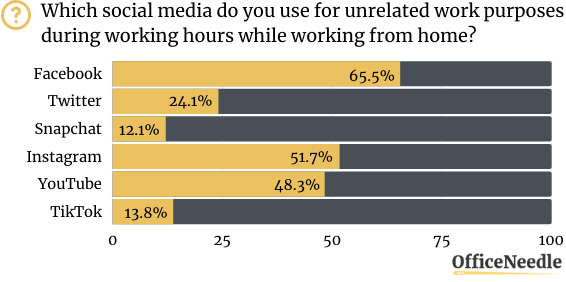
For 30% of them, social media consumption takes between 30 minutes and one hour of the shift. On the other hand, 28% of them scroll through socials for over an hour when they should be working.
However, they do not only scroll on their phones when they should be working instead. Remote workers also seem to be doing house chores and cooking food in the middle of their shifts.
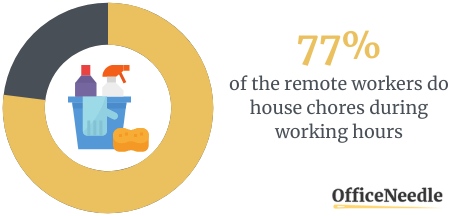
Almost 30% of survey takers admit they spend under 30 minutes cooking, while almost a quarter of them spend more than half an hour and less than an hour cleaning the house.
Remote workers who are parents also admit they take care of their children during office hours, with 31% of them caring for their children every day while working from home. Also, 40% of dog owners walk their dogs when they should be working instead.
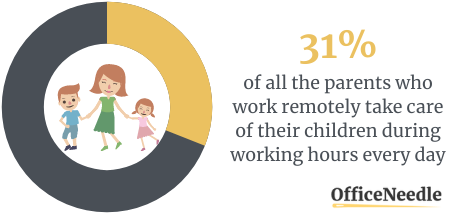
Finally, remote workers also find time to play video games and watch series and films. The study also found that remote workers shower and take naps during office hours.
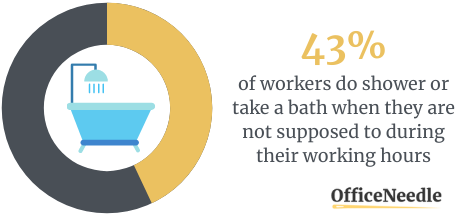
As work from home entails using the same space for work and leisure, it is no surprise that remote workers use their office hours for more than just their office duties. By feeling relaxed in their homes, they can dedicate enough time to work while also not neglecting other areas of their lives.
What Are The Most Resilient COVID-19 Industries?
COVID-19 has undoubtedly changed the world in which we live. The tough economic situation we are facing has caused some businesses to close their doors permanently. However, there are still some resilient businesses thriving in the face of the COVID-19 pandemic.
Here we’ll provide insight into the industries and businesses that have proved to be the most resilient during the COVID-19 pandemic precisely because they can quickly be done at home.
Digital Marketing
The first industry we will discuss has been around for centuries but has experienced a breath of fresh air thanks to today’s technology-driven world.
Digital marketing is responsible for high-quality websites that help businesses connect and engage with their intended audience to build their customer base and drive revenue.
There are two primary components of digital marketing: web development and web design.
Web Development
Web developers are technology professionals who build the blueprints of the websites we use every day. They develop and write the code, which ensures the website a business relies on functions properly.
You have no doubt used links on certain websites that were made possible because of web developers. For example, the “make an appointment” button on the website for a doctor’s office or a real estate agent works because of web developers’ code.
Businesses need to know their website will not only look appealing but will work as intended. There is nothing worse than broken links. This is where skilled web developers come in handy.
Web development is a coding-intensive field, but that does not mean you need a computer science degree to land the job. Some top-notch schools are offering compact web development classes, both online and in person. These classes will get you up to speed on everything you need to become a web developer.
Web Design
If web developers are the architects behind great websites, then web designers are interior decorators working on visually appealing websites. Everything you see on a website was put there in that way, in those colors, because of a web developer.
Even if a website functions properly, users won’t visit the site long if it’s not visually appealing. This can result in lost revenue for businesses. Therefore, it is up to web designers to make sure the website grabs the attention of users.
Don’t get this wrong. Web design still requires plenty of coding, but the coding is geared toward the placement of images and text rather than functionality.
Like web development, web designers do not need a four-year computer science degree or even a two-year. Web Design Bootcamps can teach you everything you need to know in just a few months.
Software Engineering
Software engineering is another industry that has proven resilient to the pitfalls of the COVID-19 pandemic. These engineers create the software we use every day, from social media platforms to countless mobile apps.
This is perhaps one of the oldest fields in computer science. Were it not for pioneering software engineers, we would not have cornerstone technology companies like Apple, Microsoft, and Facebook. All of these companies build incredible computer software through millions of lines of code.
Software engineers also write code for mobile apps. Between the incredibly high rate of new apps being built every day and all the maintenance that goes into keeping them updated, you are sure to find work in this field.
And once again, you don’t need a computer science degree to become a software engineer. If you’re looking for an in-demand job, you should learn to be a Software Engineer through boot camps and training programs.
Despite the COVID-19 pandemic hammering many economies, demand for software engineers and digital marketers has remained steady, if not grown. If you’re out of work due to COVID-19 or looking to switch careers, either field would be a sure bet to landing income.
Conclusion
While it is too soon to predict the long-lasting effects of the Covid-19 pandemic in the job market, it is already clear that we are on the path to transition to a hybrid-work model.
This, in turn, will push the need for a change in the financial aspects of work, a conversation that the tech industry is already having and that others have only to catch up with.
The above guide will help workers be more productive, no matter where they are based—in the office or the home.



